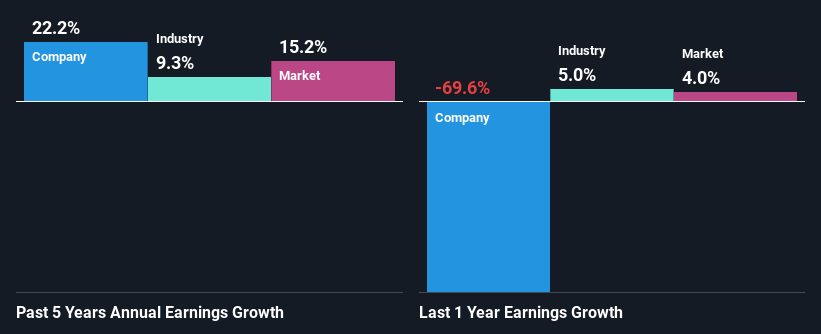The Cooper Companies, Inc.'s (NYSE:COO) Stock Has Shown Weakness Lately But Financial Prospects Look Decent: Is The Market Wrong?
With its stock down 5.8% over the past month, it is easy to disregard Cooper Companies (NYSE:COO). However, stock prices are usually driven by a company’s financials over the long term, which in this case look pretty respectable. Particularly, we will be paying attention to Cooper Companies' ROE today.
Return on equity or ROE is an important factor to be considered by a shareholder because it tells them how effectively their capital is being reinvested. Simply put, it is used to assess the profitability of a company in relation to its equity capital.
See our latest analysis for Cooper Companies
How Do You Calculate Return On Equity?
ROE can be calculated by using the formula:
Return on Equity = Net Profit (from continuing operations) ÷ Shareholders' Equity
So, based on the above formula, the ROE for Cooper Companies is:
3.9% = US$288m ÷ US$7.4b (Based on the trailing twelve months to April 2023).
The 'return' is the profit over the last twelve months. So, this means that for every $1 of its shareholder's investments, the company generates a profit of $0.04.
Why Is ROE Important For Earnings Growth?
Thus far, we have learned that ROE measures how efficiently a company is generating its profits. We now need to evaluate how much profit the company reinvests or "retains" for future growth which then gives us an idea about the growth potential of the company. Generally speaking, other things being equal, firms with a high return on equity and profit retention, have a higher growth rate than firms that don’t share these attributes.
A Side By Side comparison of Cooper Companies' Earnings Growth And 3.9% ROE
It is hard to argue that Cooper Companies' ROE is much good in and of itself. Even compared to the average industry ROE of 9.0%, the company's ROE is quite dismal. However, we we're pleasantly surprised to see that Cooper Companies grew its net income at a significant rate of 22% in the last five years. We believe that there might be other aspects that are positively influencing the company's earnings growth. For instance, the company has a low payout ratio or is being managed efficiently.
Next, on comparing with the industry net income growth, we found that Cooper Companies' growth is quite high when compared to the industry average growth of 9.3% in the same period, which is great to see.
Earnings growth is a huge factor in stock valuation. The investor should try to establish if the expected growth or decline in earnings, whichever the case may be, is priced in. This then helps them determine if the stock is placed for a bright or bleak future. Is COO fairly valued? This infographic on the company's intrinsic value has everything you need to know.
Is Cooper Companies Using Its Retained Earnings Effectively?
Cooper Companies has a really low three-year median payout ratio of 0.7%, meaning that it has the remaining 99% left over to reinvest into its business. So it looks like Cooper Companies is reinvesting profits heavily to grow its business, which shows in its earnings growth.
Besides, Cooper Companies has been paying dividends for at least ten years or more. This shows that the company is committed to sharing profits with its shareholders. Our latest analyst data shows that the future payout ratio of the company is expected to drop to 0.3% over the next three years. As a result, the expected drop in Cooper Companies' payout ratio explains the anticipated rise in the company's future ROE to 9.3%, over the same period.
Conclusion
Overall, we feel that Cooper Companies certainly does have some positive factors to consider. Despite its low rate of return, the fact that the company reinvests a very high portion of its profits into its business, no doubt contributed to its high earnings growth. We also studied the latest analyst forecasts and found that the company's earnings growth is expected be similar to its current growth rate. To know more about the company's future earnings growth forecasts take a look at this free report on analyst forecasts for the company to find out more.
Have feedback on this article? Concerned about the content? Get in touch with us directly. Alternatively, email editorial-team (at) simplywallst.com.
This article by Simply Wall St is general in nature. We provide commentary based on historical data and analyst forecasts only using an unbiased methodology and our articles are not intended to be financial advice. It does not constitute a recommendation to buy or sell any stock, and does not take account of your objectives, or your financial situation. We aim to bring you long-term focused analysis driven by fundamental data. Note that our analysis may not factor in the latest price-sensitive company announcements or qualitative material. Simply Wall St has no position in any stocks mentioned.

